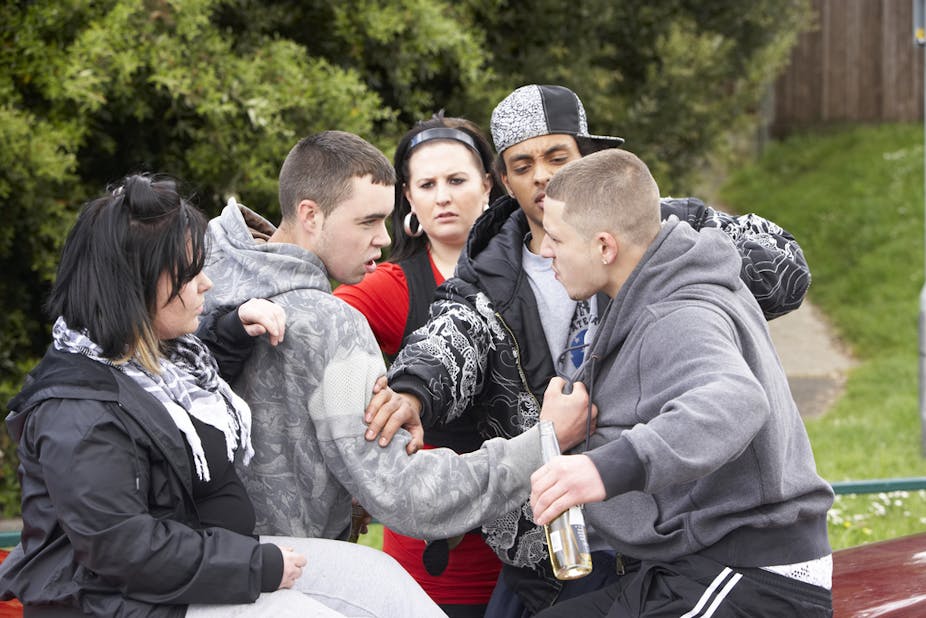A recent study by researchers at Cardiff University claimed that the number of people who attended hospital for injuries caused by violence has fallen by 12% in the past year. But to what extent can the decline be explained by a shift in behaviour among British youth?
Principal investigator Jonathan Shepherd cited an apparent shift in the nation’s alcohol consumption as a key factor. Shepherd claimed:
Binge drinking has become less frequent, and the proportion of youths who don’t drink alcohol at all has risen sharply. Also, after decades in which alcohol has become more affordable, since 2008 it has become less affordable. For people most prone to involvement in violence, those aged 18-30, falls in disposable income are probably an important factor.
In addition, the apparent decline of young men seeking treatment for drunken assaults was highlighted by the study as evidence of a tangible change in social conduct.
Using health as a measure
Cardiff’s study gathered data from 117 NHS sites across England and Wales and claimed that an estimated 234,509 people attended accident and emergency departments, minor injury units and walk-in centres for treatment following alcohol-related violence in 2013, a reduction of 32,780 compared with 2012.
In using health authority data, the study takes an innovative approach. While the findings of the Crime Survey of England and Wales, which interviews people about their experiences of crime and whether they contacted the police, also show a downward trend, the National Statistics Authority watchdog recently said that data from forces could not be considered reliable.
Crime figures, the established measure of offending rates, are known for their questionable veracity. Judicial statistics only inform us about what the police have recorded; the vast majority of criminal activity remains unreported which goes a long way to invalidate claims about fluctuations in rates of violent crime. Indeed, crime rates tell us far more about police activity than they do about criminal behaviour.

The study acknowledged that the growth of violence prevention teams involving police, NHS and local authorities “may be a factor” in the decline, but explained the decline in alcohol-related assaults among young people as the result of a reduction in disposable income and the rising cost of alcohol.
Such conclusions have arisen elsewhere in recent years. The NHS claimed in 2011 that the decline in young people seeking treatment for alcohol-related injuries was due to the “Hermione Granger” effect where teenage girls were now adopting a teetotal lifestyle as a result of the fictional heroine’s influence.
However, such claims are reductive; in this study, the hugely complex issue of violent crime is reduced to a general cause and effect relationship between affordability of alcohol and violent behaviour. Of course alcohol has an “unbuttoning” effect on social behaviour which can result in aggression – that’s undeniable – but it isn’t the sole cause of violence.
Before claiming that there has been an ascertainable shift in violent behaviour, we need to consider how people use A&E services more broadly. In a King’s Fund blog, chief economist John Appleby noted that rates of A&E attendance shouldn’t be taken at face value. But we are all aware that A&E departments across the country are under-staffed and over-worked and those who have incurred minor injuries late at night are perhaps likely to avoid a long overnight wait in A&E and seek treatment at home.

It is also important to remember that the Cardiff study discusses a particular form of violence: the bar-room brawls and late-night fisticuffs which occur in towns and cities across Britain every weekend. Yet the overwhelming majority of violence takes place in the home – hidden away from the gaze of hospitals, police and courts.
Away from public view
Domestic violence figures are continuing to increase. Fear of retribution, familial breakdown, and the costs and unlikelihood of prosecution are just a few of the reasons that victims fail to report instances of domestic abuse. Crucially, domestic violence cases are highly unlikely to ever reach court. Recent research by the House of Commons discovered that while there were 838,000 reported cases of domestic abuse in 2012-2013, a mere 52,500 (about 6%) resulted in a conviction.

Claims that violence is on the decrease as a result of low wages and high prices over-generalises the complex issue of violent crime. If alcohol-related violence is really decreasing, for example, then how do we explain the increases in reporting of domestic and sexual abuse? An interrogation of the ways in which society uses A&E services is needed in order to substantiate the bold claims made by Cardiff’s study.

